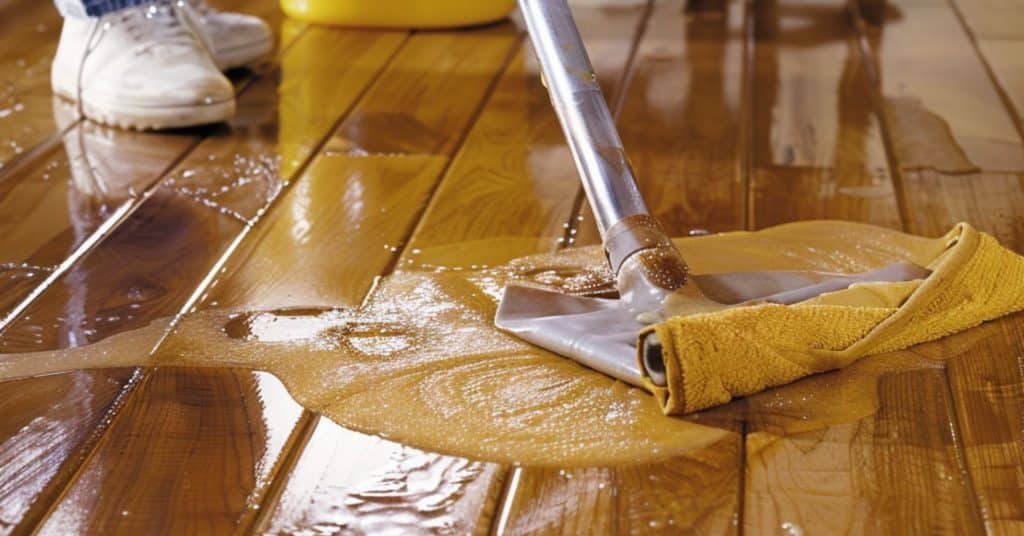When it comes to maintaining the elegance of wooden floors, everyone has their own secret formula. But what many don’t realize is that the durability of these floors often comes from a polyurethane finish, making them not only beautiful but also resilient.
Despite their toughness, wooden floors aren’t immune to the wear and tear of daily life. They require regular maintenance to keep their luster, and every once in a while, they need a deep clean to bring back their original shine.
We understand the challenge of finding the right way to care for these surfaces without causing damage. That’s why we’ve put together expert advice on how to deep clean wooden floors effectively.
Our guide is designed to help you navigate through the process, ensuring that your floors remain in pristine condition. Join us as we delve into the best practices for keeping your wooden floors looking their best.
Understanding Wooden Floors and Their Care
Types of Wooden Floor Finishes
Knowing the finish on your wooden floors is crucial for proper care. There are primarily two: surface finishes, like polyurethane, which protect floors with a durable coat; and penetrating finishes, which soak into the wood and offer protection from within, usually requiring wax for added shine.
Each type demands a specific approach to cleaning and maintenance. If you’ve got a surface finish, you’re in luck for easy cleaning, but those with penetrating finishes will need a bit more elbow grease and a careful selection of cleaning products.
Signs Your Wooden Floor Needs Deep Cleaning
Spotting when your wooden floors need a thorough clean isn’t rocket science.
First off, if your floor seems to have lost its luster or shine, it’s screaming for a deep clean. Another telltale sign is the presence of sticky residues or discolorations, which usually means spills have been left unattended too long.
Lastly, if you start to notice an unusual amount of scratches or scuffs that seem to stand out more than usual, it’s definitely time to roll up your sleeves. Remember, consistent foot traffic can gradually dull the appearance of your floors, making regular maintenance key to keeping them looking their best.
Preparing to Deep Clean Wooden Floors
Essential Tools and Supplies
When diving into deep cleaning wooden floors, grabbing the right tools and supplies is our first step. We need a arsenal that includes a dust mop, preferably a microfiber one, to trap dirt and debris without scratching the floors.
A vacuum without a beater bar is another must-have, essential for removing more stubborn dirt and pet hair that a mop may well miss.
Finally, our cleaning solution – a mix of distilled white vinegar and water provides a natural yet effective way to lift grime. A soft-bristled brush and a microfiber cloth round off our toolkit, ensuring we’re equipped to tackle the task with precision.
Preliminary Cleaning: Sweeping and Vacuuming
Before we get down to the nitty-gritty, removing loose dirt and debris is crucial. We start by sweeping or using a dry microfiber mop to collect any surface dust.
Following this, vacuuming comes into play, crucial for removing finer particles that sweeping may well not catch. This step isn’t just about cleanliness; it’s about setting the stage for a deeper clean.
We focus on high-traffic areas and those easy-to-miss corners, ensuring our wooden floors are ready for the thorough cleaning they deserve. By doing so, we’re not just cleaning — we’re laying the groundwork for wooden floors that stay looking beautiful for longer.
Step-by-Step Guide to Deep Cleaning Wooden Floors
Removing Surface Dirt and Debris
First off, grab that trusty dust mop or a vacuum without the beater bar. Our goal here is to sweep away life’s little messes from your floors. This is your starting line, so make it count. A clean sweep ensures the rest of our cleaning marathon runs smoothly, with no leftover grit to scratch the surface.
Choosing the Right Cleaning Solution
Here’s where it gets a bit tricky. Depending on your floor’s finish, whether it’s polyurethane or has a penetrating finish, the cleaning solution varies.
However, a safe bet always lies in the simplicity of warm water mixed with distilled white vinegar. Just remember, a little goes a long way here. We’re cleaning, not pickling your floors!
Tackling Tough Stains and Spills
Encountered a tough spot? Don’t panic. Combine that vinegar solution with a soft-bristled brush or cloth, dabbing gently on the villainous stain. For the extra stubborn ones, a mix of dish soap and water may well just be your hero. Patience is key; give the solution some time to work its magic before wiping it away.
Mopping Strategies for Wooden Floors
Mopping can feel like an art form, but let’s keep it simple. Dip your mop in the cleaning solution, wring it out well, because remember, wooden floors aren’t fans of too much water. Then, glide the mop along the floor, going with the grain of the wood. It’s like giving your floor a gentle, cleansing massage.
Drying and Buffing for a Perfect Finish
Finally, let’s not leave our floors damp. Use a clean, dry microfiber cloth to wipe any excess moisture. For that showroom shine, give the floor a gentle buff. Now step back, admire your work, and enjoy the satisfaction of deeply cleaned wooden floors. Remember, a little care goes a long way.
Maintaining Your Deep Cleaned Floors
Regular Cleaning Habits
After giving your wooden floors a thorough cleaning, sticking to a regular cleaning schedule ensures they stay looking their best. We recommend sweeping or dusting every few days to remove surface debris.
For a more thorough clean, vacuum weekly using a hardwood-friendly vacuum cleaner to prevent any scratches or damage. Incorporating a gentle mop with a recommended hardwood floor cleaner monthly will address any dirt build-up, keeping your floors shining without over-wetting them.
Preventing Damage and Stains
Accidents happen, but minimizing damage to your floors is key to keeping them in top shape. Place mats at entrances to catch dirt before it hits your floors. Encourage a shoes-off policy to avoid tracking in grime and potentially scratching the surface.
For unavoidable spills, wipe them up promptly with a soft, dry cloth. Using protective pads under furniture legs also goes a long way in preventing unsightly scratches and indents.
When to Refinish Your Wooden Floors
Over time, even the best-maintained floors may show signs of wear. If your floors look dull even after cleaning, it may well be time to consider refinishing. Typically, wooden floors need refinishing every 7 to 10 years, depending on traffic and usage.
Refinishing not only revitalizes the look of your floors but also provides an opportunity to apply a new protective topcoat, extending their life and beauty. Remember, a beautifully maintained wooden floor enhances the overall ambiance of your home, making these efforts well worth it.
See more:

